Constitution of Composite Cross Maize (Zea mays L.) Populations Selected for the Semi-Arid Environment of South Madagascar
Abstract
1. Introduction
2. Materials and Methods
2.1. Study Area and Soil Management
2.2. Inbred Line Constitutions and Their Agronomic Evaluations through Half-Sib Progeny
2.3. Population Constitution and Seed Multiplication
2.4. Seed Multiplication and Comparison between the New CCP Population with Hybrid and Local Variety Production in Open Fields
2.5. Statistical Analysis
3. Results
4. Discussion
5. Conclusions
Supplementary Materials
Author Contributions
Funding
Acknowledgments
Conflicts of Interest
References
- Žilić, S.; Serpen, A.; Akıllıoğlu, G.; Gökmen, V.; Vančetović, J. Phenolic compounds, carotenoids, anthocyanins, and antioxidant capacity of coloured maize (Zea mays L.) kernels. J. Agric. Food Chem. 2012, 60, 1224–1231. [Google Scholar] [CrossRef] [PubMed]
- Doria, E.; Daoudou, B.; Egal, A.K.; Oldewage-Theron, W.H.; Pilu, R. Preliminary analysis and biochemical characterization related to health implications for African populations in some maize cultivars. A special look at the South African environment. J. Food Sci. Nutr. 2015, 1, 1–7. [Google Scholar] [CrossRef]
- FAO (Food and Agriculture Organization of the United Nations). GIEWS—Global Information and Early Warning System—Country Briefs; FAO: Antananarivo, Madagascar, 2016. [Google Scholar]
- Sasson, A. Food security for Africa: An urgent global challenge. Agric. Food Secur. 2012, 1, 2. [Google Scholar] [CrossRef]
- Gaffney, J.; Anderson, J.; Franks, C.; Collinson, S.; MacRobert, J.; Woldemariam, W.; Albertsen, M. Robust seed systems, emerging technologies, and hybrid crops for Africa. Glob. Food Secur. 2016, 9, 36–44. [Google Scholar] [CrossRef]
- UNDP. Sustainability and Equity: A Better Future for All; Human Development Report 2011; United Nations Development Program: New York, NY, USA, 2011. [Google Scholar]
- Dostie, B.; Haggblade, S.; Randriamamonjy, J. Seasonal poverty in Madagascar: Magnitude and solutions. Food Policy 2002, 27, 493–518. [Google Scholar] [CrossRef]
- Zeller, M.; Lapneu, C.; Minten, B.; Ralison, E.; Randrianaivo, D.; Randrianarisoa, C. Pathways of rural development in Madagascar: An empirical investigation of the critical triangle between environmental sustainability, economic growth and poverty alleviation. Q. J. Int. Agric. 1999, 2, 105–127. [Google Scholar]
- Minten, B.; Barrett, C.B. Agricultural technology, productivity, and poverty in Madagascar. World Dev. 2008, 36, 797–892. [Google Scholar] [CrossRef]
- Ray, D.K.; Mueller, N.D.; West, P.C.; Foley, J.A. Yield Trends Are Insufficient to Double Global Crop Production by 2050. PLoS ONE 2013, 8, e66428. [Google Scholar] [CrossRef]
- FAOSTAT. 2014. Available online: http://www.fao.org/faostat/en/#data/QC (accessed on 14 December 2018).
- Kandji, S.T.; Verchot, L.; Mackensen, J. Climate Change and Variability in the Sahel Region: Impacts and Adaptation Strategies in the agricultural Sector; United Nations Environmental Programme and World Agroforestry Center: Nairobi, Kenya, 2006. [Google Scholar]
- Mengesha, W.A. Genetic Diversity, Stability, and Combining Ability of Maize Genotypes for Grain Yield and Resistance to NCLB in the Mid-Altitude Sub-Humid Agro-Ecologies of Ethiopia. Ph.D. Thesis, University of KwaZulu-Natal, Durban, South Africa, 2013. [Google Scholar]
- Challinor, A.J.; Koehler, A.K.; Ramirez-Villegas, J.; Whitfield, S.; Das, B. Current warming will reduce yields unless maize breeding and seed systems adapt immediately. Nat. Clim. Chang. 2016, 6, 954–958. [Google Scholar] [CrossRef]
- Wheeler, T.; von Braun, J. Climate change impacts on global food security. Science 2013, 341, 508–513. [Google Scholar] [CrossRef]
- Shiferaw, B.; Tesfaye, K.; Kassie, M.; Abate, T.; Prasanna, B.M.; Menkir, A. Managing vulnerability to drought and enhancing livelihood resilience in sub-Saharan Africa: Technological, institutional and policy options. Weather Clim. Extrem. 2014, 3, 67–79. [Google Scholar] [CrossRef]
- Abadassi, J. Comparison of two types of improved tropical maize populations in Benin. Afr. J. Agric. Res. 2013, 8, 952–956. [Google Scholar]
- Ceccarelli, S.; Grando, S.; Maatougui, M.; Michael, M.; Slash, M.; Haghparast, R.; Rahmanian, M.; Taheri, A.; Al-Yassin, A.; Benbelkacem, A.; et al. Plant breeding and climate changes. J. Agric. Sci. 2010, 148, 627–637. [Google Scholar] [CrossRef]
- Matthews, R.B.; Rivington, M.; Muhammed, S.; Newton, A.C.; Hallett, P.D. Adapting crops and cropping systems to future climates to ensure food security: The role of crop modelling. Glob. Food Secur. 2013, 2, 24–28. [Google Scholar] [CrossRef]
- Weedon, O.D. Using Crop Genetic Diversity to Improve Resilience: Agronomic Potential of Evolutionary Breeding under Differing Management Systems. Ph.D. Thesis, University of Kassel, Kassel, Germany, 2019. Available online: https://kobra.uni-kassel.de (accessed on 14 May 2019).
- Döring, T.F.; Knapp, S.; Kovacs, G.; Murphy, K.; Wolfe, M.S. Evolutionary plant breeding in cereals into a new era. Sustainability 2011, 3, 1944–1971. [Google Scholar] [CrossRef]
- Prasanna, B.M. Developing and deploying abiotic stress-tolerant maize varieties in the tropics: Challenges and opportunities. In Molecular Breeding for Sustainable Crop Improvement; Rajpal, V.R., Rao, S.R., Raina, S.N., Eds.; Springer: Cham, Switzerland, 2016; pp. 61–77. [Google Scholar]
- Cairns, J.E.; Prasanna, B.M. Developing and deploying climate-resilient maize varieties in the developing world. Curr. Opin. Plant Biol. 2018, 45, 226–230. [Google Scholar] [CrossRef]
- Swiderska, K.; Reid, H.; Song, Y.; Mutta, D.; Ongugo, P.; Pakia, M.; Barriga, S. Traditional Knowledge and Crop Varieties as Adaptation to Climate Change in South-West China, the Bolivian Andes and Coastal Kenya. In Indigenous Knowledge for Climate Change Assessment and Adaptation; Nakashima, D., Krupnik, I., Rubis, J.T., Eds.; Cambridge University Press: Cambridge, UK, 2018; pp. 152–168. [Google Scholar] [CrossRef]
- Hellin, J.; Bellon, M.R.; Hearne, S.J. Maize landraces and adaptation to climate change in Mexico. J. Crop Improv. 2014, 28, 484–501. [Google Scholar] [CrossRef]
- Anđelković, V.; Ristić, D.; Babić, V.; Dumanović, Z.; Kravić, N. Maize landraces as a source of adaptation to climatic change. Ratarstvo I Povrtarstvo 2016, 53, 24–29. [Google Scholar] [CrossRef]
- Simmonds, N.W. Selection for local adaptation in a plant breeding programme. Theor. Appl. Genet. 1991, 82, 363–367. [Google Scholar] [CrossRef]
- Dwivedi, S.L.; Ceccarelli, S.; Blair, M.W.; Upadhyaya, H.D.; Are, A.K.; Ortiz, R. Landrace germplasm for improving yield and abiotic stress adaptation. Trends Plant Sci. 2016, 21, 31–42. [Google Scholar] [CrossRef]
- Witcombe, J.R.; Virk, D.S. Number of crosses and population size for participatory and classical plant breeding. Euphytica 2001, 122, 451–462. [Google Scholar] [CrossRef]
- Bertan, I.; Carvalho, F.I.F.; Oliveira, A.D. Parental selection strategies in plant breeding programs. J. Crop Sci. Biotechnol. 2007, 10, 211–222. [Google Scholar]
- Ceccarelli, S.; Guimarães, E.P.; Weltzien, E. Plant Breeding and Farmer Participation; Food and Agriculture Organization of the United Nations: Rome, Italy, 2009. [Google Scholar]
- Semagn, K.; Magorokosho, C.; Vivek, B.S.; Makumbi, D.; Beyene, Y.; Mugo, S.; Prasanna, B.M.; Warburton, M.L. Molecular characterization of diverse CIMMYT maize inbred lines from eastern and southern Africa using single nucleotide polymorphic markers. BMC Genom. 2012, 13, 113. [Google Scholar] [CrossRef] [PubMed]
- Windhausen, V.S.; Atlin, G.N.; Hickey, J.M.; Crossa, J.; Jannink, J.L.; Sorrells, M.E.; Raman, B.; Cairns, J.E.; Tarekegne, A.; Semagn, K.; et al. Effectiveness of genomic prediction of maize hybrid performance in different breeding populations and environments. G3-Genes Genom. Genet. 2012, 2, 1427–1436. [Google Scholar] [CrossRef] [PubMed]
- Betrán, F.J.; Ribaut, J.M.; Beck, D.; De Leon, D.G. Genetic diversity, specific combining ability, and heterosis in tropical maize under stress and nonstress environments. Crop Sci. 2003, 43, 797–806. [Google Scholar] [CrossRef]
- Beck, D.; Betrán, F.J.; Bänziger, M.; Willcox, M.; Edmeades, G.O. From landrace to hybrid: Strategies for the use of source populations and lines in the development of drought tolerant cultivars. In Developing Drought and Low N-Tolerant Maize; Edmeades, G.O., Bänziger, M., Mickelson, H.R., Peña-Valdivia, C.B., Eds.; CIMMYT: El Batán, Mexico, 1996; pp. 369–382. [Google Scholar]
- Witcombe, J.R.; Joshi, A.; Joshi, K.D.; Sthapit, B.R. Farmer participatory crop improvement. I. Varietal selection and breeding methods and their impact on biodiversity. Exp. Agric. 1996, 32, 445–460. [Google Scholar] [CrossRef]
- Dhliwayo, T.; Pixley, K.; Menkir, A.; Warburton, M. Combining ability, genetic distances, and heterosis among elite CIMMYT and IITA tropical maize inbred lines. Crop Sci. 2009, 49, 1201–1210. [Google Scholar] [CrossRef]
- Borges, V.; Ferreira, P.V.; Soares, L.; Santos, G.M.; Santos, A.M.M. Sweet potato clone selection by REML/BLUP procedure. Acta Sci. Agron. 2010, 32, 643–649. [Google Scholar]
- Almeida Filho, J.E.D.; Tardin, F.D.; Resende, M.D.V.D.; Granato, Í.S.C.; Menezes, C.B.D. Genetic evaluation of grain sorghum hybrids in Brazilian environments using the REML/BLUP procedure. Sci. Agric. 2014, 71, 146–150. [Google Scholar] [CrossRef]
- Viana, J.M.S.; Sobreira, F.M.; De Resende, M.D.V.; Faria, V.R. Multi-trait BLUP in half-sib selection of annual crops. Plant Breed. 2010, 129, 599–604. [Google Scholar] [CrossRef]
- Suneson, C.A. Evolutionary Plant Breeding 1. Crop Sci. 1969, 9, 119–121. [Google Scholar] [CrossRef]
- Campanelli, G.; Acciarri, N.; Campion, B.; Delvecchio, S.; Leteo, F.; Fusari, F.; Angelini, P.; Ceccarelli, S. Participatory tomato breeding for organic conditions in Italy. Euphytica 2015, 204, 179–197. [Google Scholar] [CrossRef]
- Ceccarelli, S. Efficiency of plant breeding. Crop Sci. 2015, 55, 87–97. [Google Scholar] [CrossRef]
- Raggi, L.; Ciancaleoni, S.; Torricelli, R.; Terzi, V.; Ceccarelli, S.; Negri, V. Evolutionary breeding for sustainable agriculture: Selection and multi-environmental evaluation of barley populations and lines. Field Crop. Res. 2017, 204, 76–88. [Google Scholar] [CrossRef]
- Ceccarelli, S.; Grando, S.; Baum, M. Participatory plant breeding in water-limited environments. Exp. Agric. 2007, 43, 411–435. [Google Scholar] [CrossRef]
- Phillips, S.L.; Wolfe, M.S. Evolutionary plant breeding for low input systems. J. Agric. Sci. 2005, 143, 245–254. [Google Scholar] [CrossRef]
- Palchetti, E.; Calamai, A.; Valenzi, E.; Rella, G.; Whittaker, A.; Masoni, A.; Bindi, M.; Moriondo, M.; Brilli, L. Open field screening of the productive parameters, protein content, phenolic compounds, and antioxidant capacity of maize (Zea mays L.) in the marginal uplands of southern Madagascar. J. Agric. Rural. Dev. Trop. Subtrop. 2019, 120, 45–54. [Google Scholar]
- Longley, C.; Jones, R.; Ahmed, M.H.; Audi, P. Seed Sector Study of Southern Somalia; Final Report Submitted to the EC Somalia Unit; Overseas Development Institute: London, UK, 2001. [Google Scholar]
- Gavin, R.; Haji, H.; Jelinski, N.; Porter, P. An on-farm comparison of the agronomics and economics of irrigated maize production systems in the Somali Deyr season. Afr. J. Agric. Res. 2018, 13, 1177–1185. [Google Scholar]
- Meier, U. Growth Stages of Mono-and Dicotyledonous Plants, 2nd ed.; Federal Biological Research Centre for Agriculture and Forestry: Braunschweig, Germany, 2001. [Google Scholar]
- Acquaah, G. Principles of Plant Genetics and Breeding, 2nd ed.; John Wiley & Sons: Oxford, UK, 2009. [Google Scholar]
- Ramakrishna, W.; Martin, B.; Jinsheng, L.; Chittaranjan, K. Genetics, Genomics and Breeding of Maize; Genetics, Genomics and Breeding of Crop Plants; CRC Press: New York, NY, USA, 2014. [Google Scholar]
- Alvarado, G.; López, M.; Vargas, M.; Pacheco, A.; Rodríguez, F.; Burgueño, J.; Crossa, J. META-R (Multi Environment Trial Analysis with R for Windows.) Version 6.0. 2016. Available online: http://hdl.handle.net/11529/10201 (accessed on 1 November 2019).
- Hallauer, A.R.; Carena, M.J.; Miranda Filho, J.D. Quantitative Genetics in Maize Breeding; Springer Science & Business Media: New York, NY, USA, 2010. [Google Scholar]
- R Core Team. R: A Language and Environment for Statistical Computing; R Foundation for Statistical Computing: Vienna, Austria, 2013. [Google Scholar]
- Kassambara, A.; Mundt, F. Extract and Visualize the Results of Multivariate Data Analyses. R Package “Factoextra” Version 1.0-5. Comprehensive R Arch. Network. Available online: https://cran.r-project.org/package=factoextra (accessed on 1 November 2019).
- Calamai, A.; Masoni, A.; Palchetti, E.; Grassi, C.; Brilli, L. Evaluation of Agronomic Performance and Seed Oil Composition of 15 Sunflower Genotypes in South Madagascar. Agric. Sci. 2018, 9, 1337–1353. [Google Scholar] [CrossRef]
- Döring, T.F.; Annicchiarico, P.; Clarke, S.; Haigh, Z.; Jones, H.E.; Pearce, H.; Snape, J.; Zhan, J.; Wolfe, M.S. Comparative analysis of performance and stability among composite cross populations, variety mixtures and pure lines of winter wheat in organic and conventional cropping systems. Field Crop. Res. 2015, 183, 235–245. [Google Scholar] [CrossRef]
- Kutka, F.J.; Smith, M.E. How many parents give the highest yield in predicted synthetic and composite populations of maize? Crop Sci. 2007, 47, 1905–1913. [Google Scholar] [CrossRef]
- Barbosa, M.H.P.; De Resende, M.D.V.; Peternelli, L.A.; Bressiani, J.A.; da Silveira, L.C.I.; da Silva, F.L.; de Figueiredo, I.C.R. Use of REML/BLUP for the selection of sugarcane families specialized in biomass production. Crop Breed. Appl. Biotechnol. 2004, 4, 218–226. [Google Scholar]
- Nardino, M.; Baretta, D.; Carvalho, I.R.; Olivoto, T.; Follmann, D.N.; Szareski, V.I.J.; Ferrari, M.; de Pelegrin, A.J.; Konflanz, V.A.; de Souza, V.Q.O. Restricted maximum likelihood/best linear unbiased prediction (REML/BLUP) for analyzing the agronomic performance of corn. Afr. J. Agric. Res. 2016, 11, 4864–4872. [Google Scholar]
- Oluwaranti, A.; Fakorede, M.A.B.; Adeboye, F.A. Maturity groups and phenology of maize in a rainforest location. Int. J. Agric. Res. Innov. Technol. 2015, 4, 124–127. [Google Scholar]
- Huang, R.; Birch, C.J.; George, D.L. Water Use Efficiency in Maize Production-the Challenge and Improvement Strategies; Maize Association of Australia: Darlington Point, Australia, 2006. [Google Scholar]
- Alves, M.L.; Belo, M.; Carbas, B.; Brites, C.; Paulo, M.; Mendes-Moreira, P.; Brites, C.; Bronze, M.D.; Šatović, Z.; Vaz Patto, M.C. Long-term on-farm participatory maize breeding by stratified mass selection retains molecular diversity while improving agronomic performance. Evol. Appl. 2018, 11, 254–270. [Google Scholar] [CrossRef] [PubMed]
- Döring, T.F.; Knapp, S.; Cohen, J.E. Taylor’s power law and the stability of crop yields. Field Crop. Res. 2015, 183, 294–302. [Google Scholar] [CrossRef]
- Newton, A.C.; Begg, G.S.; Swanston, J.S. Deployment of diversity for enhanced crop function. Ann. Appl. Biol. 2009, 154, 309–322. [Google Scholar] [CrossRef]
- Kutka, F. Open-pollinated vs. hybrid maize cultivars. Sustainability 2011, 3, 1531–1554. [Google Scholar] [CrossRef]
- Chimonyo, V.G.; Mutengwa, C.S.; Chiduza, C. Genotype × environment interactions and yield stability of stress-tolerant open-pollinated maize varieties in the Eastern Cape province, South Africa. S. Afr. J. Plant Soil 2014, 31, 61–68. [Google Scholar] [CrossRef]
- Incognito, S.; Eyhérabide, G.; López, C. Can elite maize landraces help to improve forage yield and quality? A genetic analysis. Maydica 2018, 61, 10. [Google Scholar]
- Lee, E.A.; Tracy, W.F. Modern maize breeding. In Handbook of Maize; Springer: New York, NY, USA, 2009; pp. 141–160. [Google Scholar]
- Pingali, P.L.; Heisey, P.W. Cereal-crop productivity in developing countries: Past trends and future prospects. In Agricultural Science Policy: Changing Global Agendas; Alston, J.M., Perdey, P.G., Taylor, M.J., Eds.; The Johns Hopkins University Press: London, UK, 2001. [Google Scholar]
- Stagnari, F.; Onofri, A.; Codianni, P.; Pisante, M. Durum wheat varieties in N-deficient environments and organic farming: A comparison of yield, quality and stability performances. Plant Breed. 2013, 132, 266–275. [Google Scholar] [CrossRef]
- Ceccarelli, S. Specific adaptation and breeding for marginal conditions. In Breeding Fodder Crops for Marginal Conditions; Rognli, O.A., Solberg, E., Schjelderup, I., Eds.; Springer: Dordrecht, The Netherlands, 1994. [Google Scholar]
- Murphy, K.; Lammer, D.; Lyon, S.; Carter, B.; Jones, S.S. Breeding for organic and low-input farming systems: An evolutionary–participatory breeding method for inbred cereal grains. Renew. Agric. Food Syst. 2005, 20, 48–55. [Google Scholar] [CrossRef]
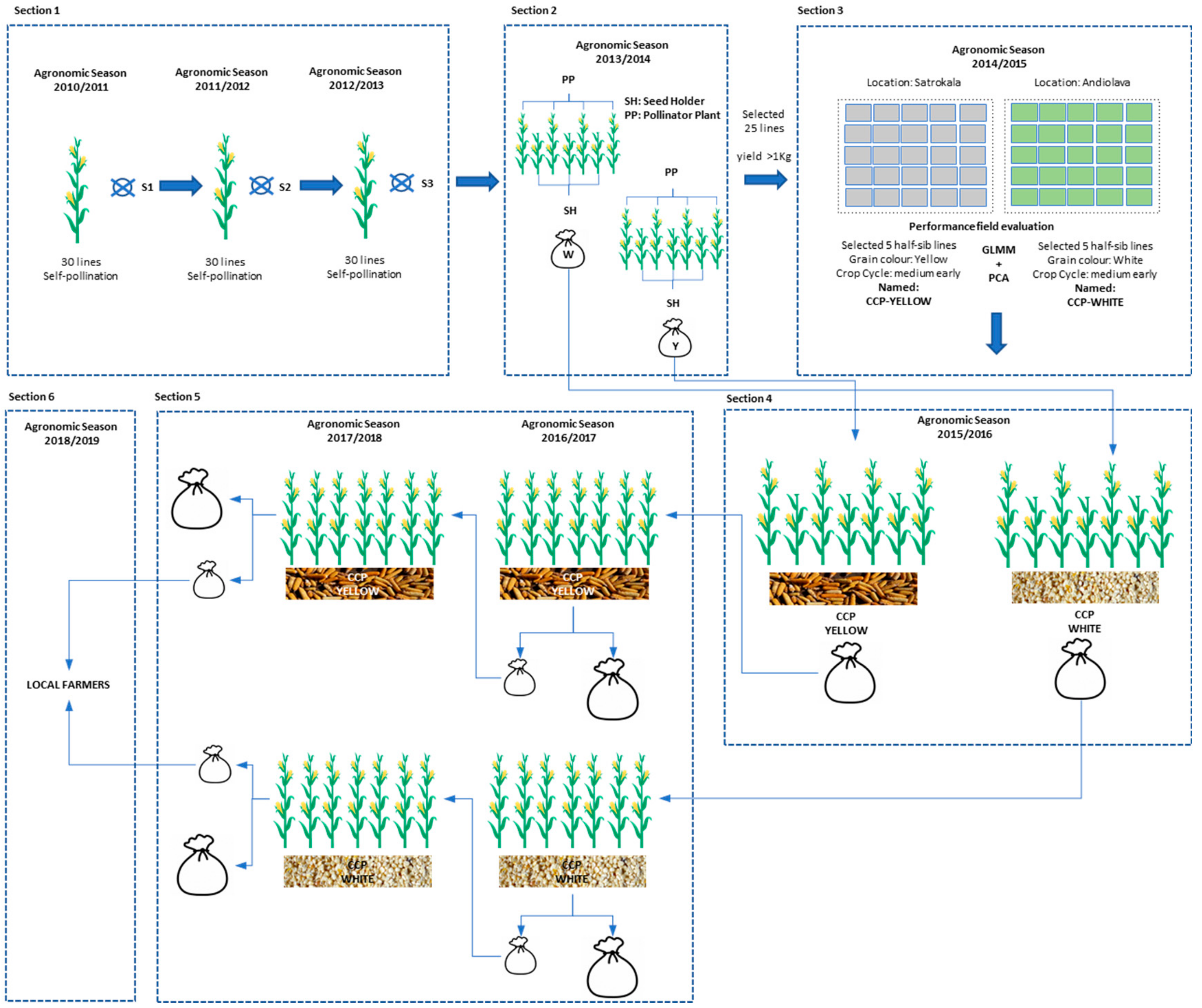
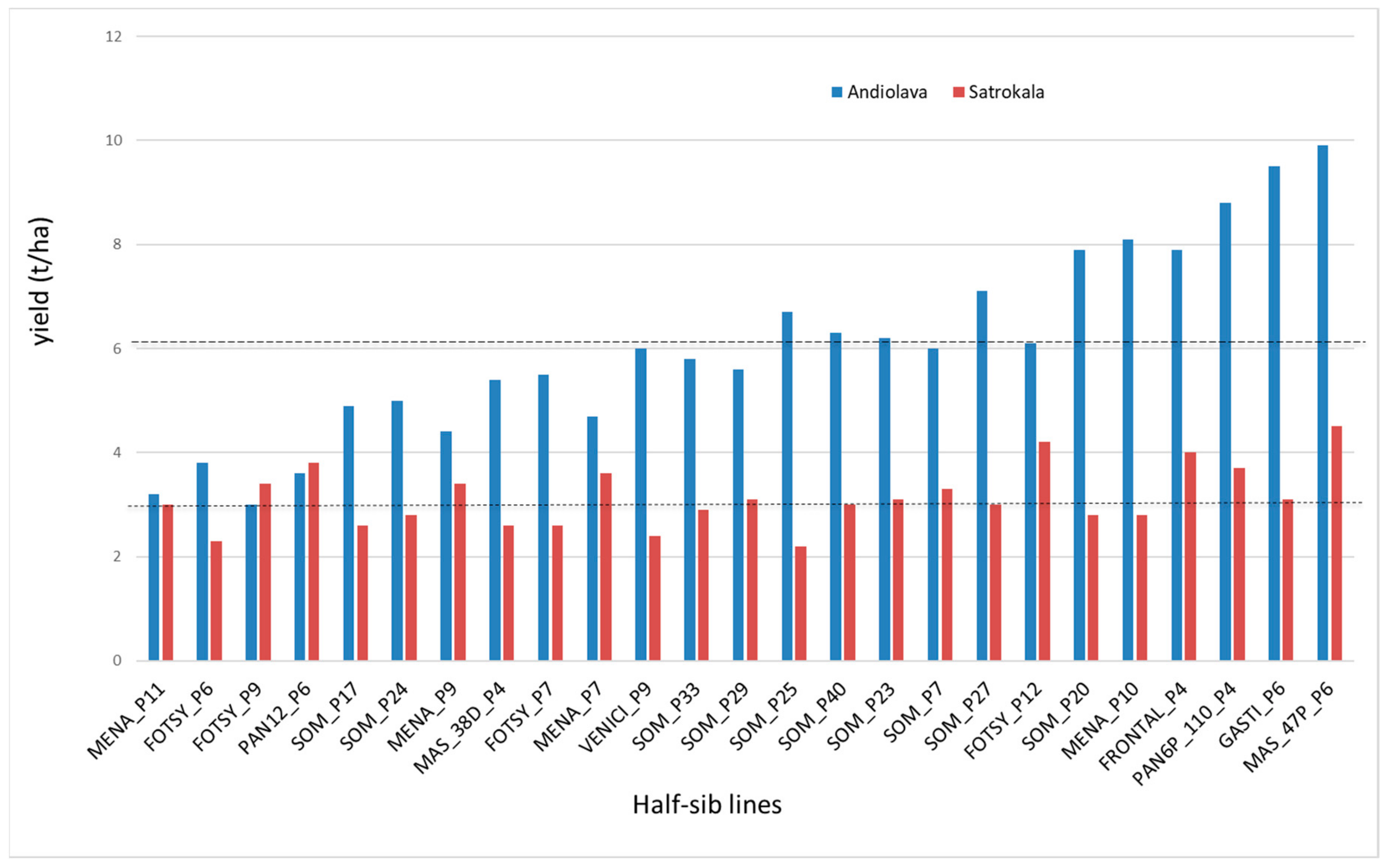
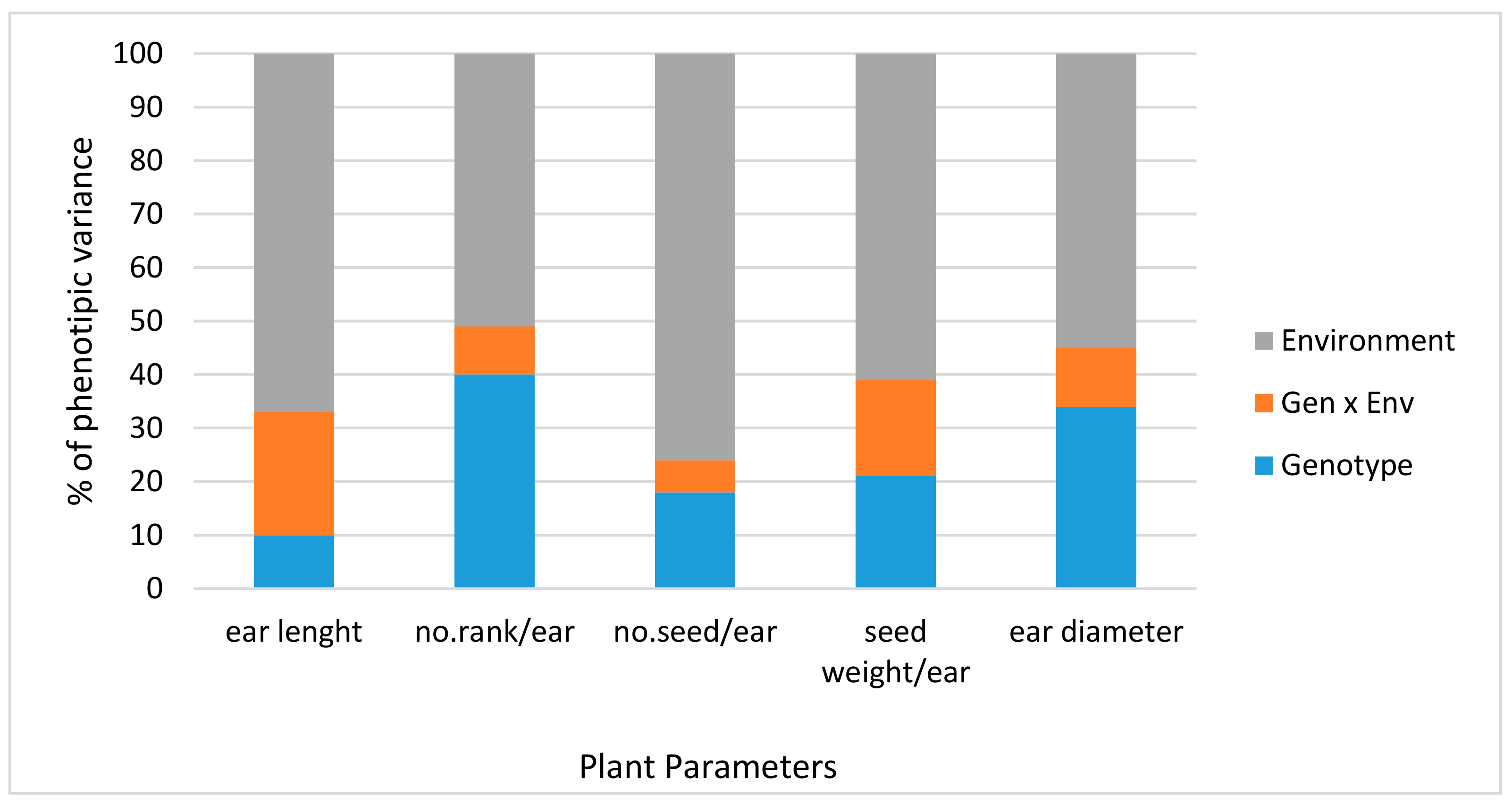
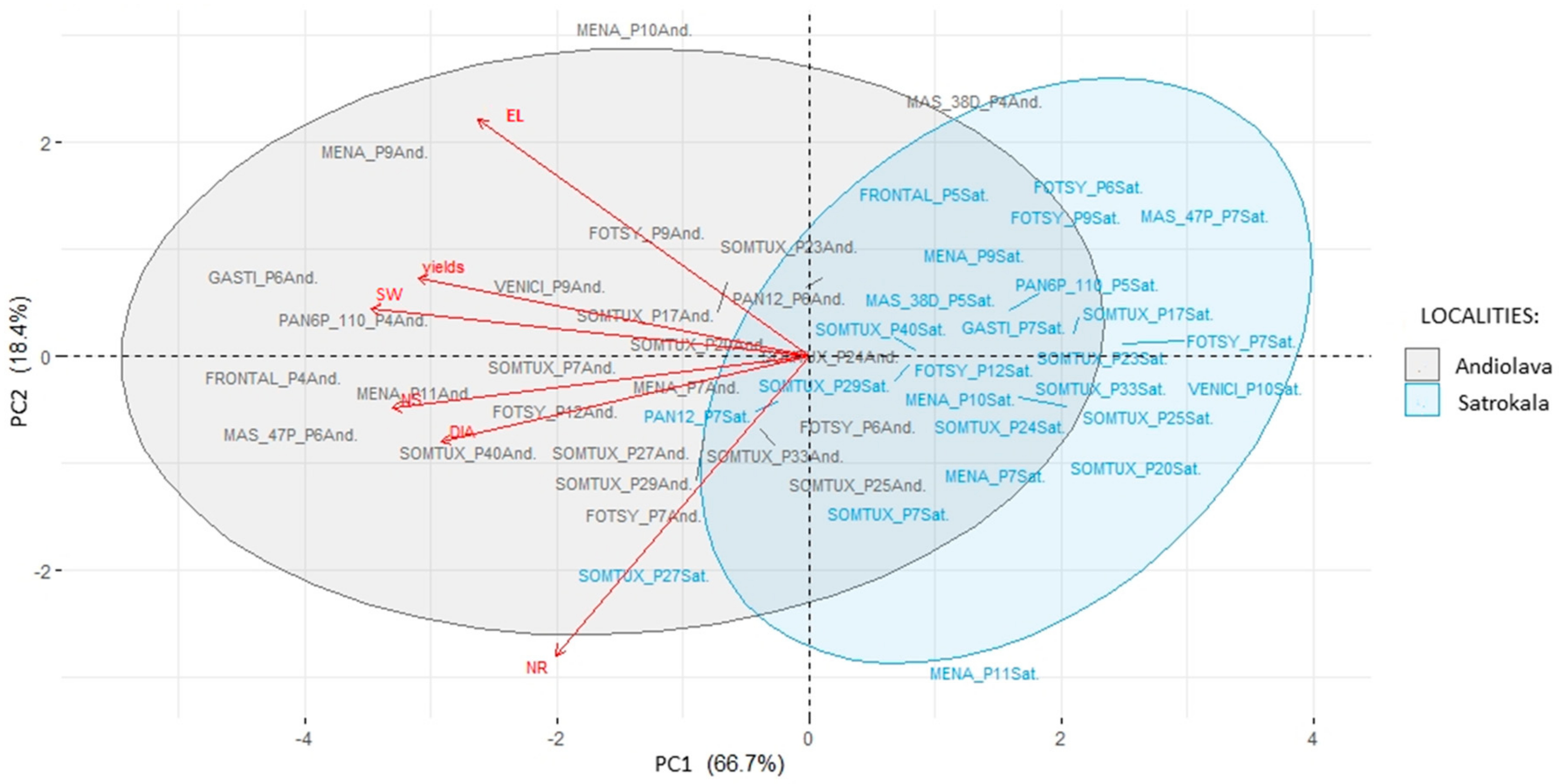
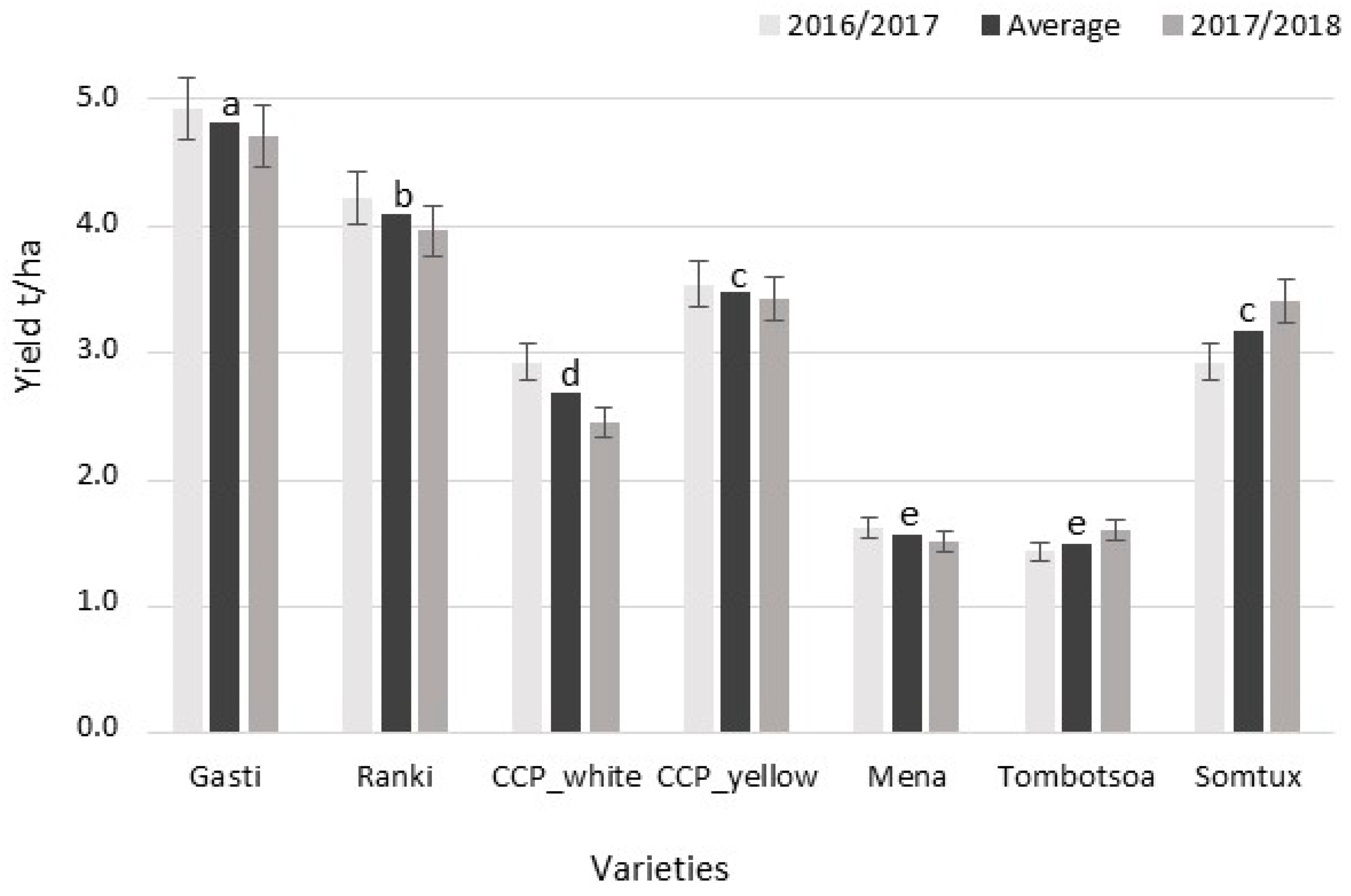
| Line Name | Origin | Kernel Colour | Half-Sib Yields (g) |
|---|---|---|---|
| SOM_P17 | Somalian population | White | 1338 |
| SOM_P20 | Somalian population | White | 1343 |
| SOM_P23 | Somalian population | White | 2456 |
| SOM_P24 | Somalian population | White | 2091 |
| SOM_P25 | Somalian population | White | 1793 |
| SOM_P27 | Somalian population | White | 1950 |
| SOM_P29 | Somalian population | White | 2238 |
| SOM_P31 | Somalian population | White | 1896 |
| SOM_P33 | Somalian population | White | 2013 |
| SOM_P7 | Somalian population | White | 1527 |
| FOTSY_P5 | local landraces | White | 258 |
| FOTSY_P6 | local landraces | White | 1011 |
| FOTSY_P7 | local landraces | White | 1338 |
| FOTSY_P12 | local landraces | White | 2666 |
| FOTSY_P9 | local landraces | White | 2303 |
| MENA_P9 | local landraces | Yellow | 1859 |
| MENA_P10 | local landraces | Yellow | 2704 |
| MENA_P11 | local landraces | Yellow | 1187 |
| MENA_P7 | local landraces | Yellow | 1317 |
| MENA_P13 | local landraces | Yellow | 750 |
| PAN6P_110_P4 | commercial hybrid | Yellow | 4081 |
| PAN12_P6 | commercial hybrid | Yellow | 3122 |
| MAS_55F_P5 | commercial hybrid | Yellow | 401 |
| MAS_47D_P6 | commercial hybrid | Yellow | 2383 |
| MAS_38D_P4 | commercial hybrid | Yellow | 1940 |
| GASTI_P6 | commercial hybrid | Yellow | 3426 |
| FRONTAL_P4 | commercial hybrid | Yellow | 2051 |
| VENICI_P9 | commercial hybrid | Yellow | 1427 |
| YOGGI_P12 | commercial hybrid | Yellow | 150 |
| CLARITY_P9 | commercial hybrid | Yellow | 850 |
| Variety | Ear Lenght | No. Rank/Ear | No. Seed/Ear | Seed Wheight (g)/Ear | Ear Diameter (cm) | Yields (t/ha) | |||||
|---|---|---|---|---|---|---|---|---|---|---|---|
| Mean | BLUP | Mean | BLUP | Mean | BLUP | Mean | BLUP | Mean | BLUP | Mean | |
| VENICI_P9 | 14.35ab | 10.10 | 14 | 10 | 422.80 | 328.69 | 118.10c | 86.13 | 4.52ab | 4.04 | 4.20 |
| SOMTUX_P7 | 14.48ab | 10.04 | 14 | 10 | 476.60 | 329.65 | 132.05ab | 85.83 | 4.65a | 3.98 | 4.65 |
| SOMTUX_P40 | 14.59ab | 10.22 | 14 | 12 | 524.10 | 331.15 | 131.55ab | 87.29 | 4.47ab | 4.04 | 4.65 |
| SOMTUX_P33 | 13.32ab | 9.91 | 16 | 12 | 470.90 | 331.33 | 110.35d | 85.29 | 3.77b | 3.93 | 4.35 |
| SOMTUX_P29 | 14.32ab | 10.09 | 16 | 10 | 489.50 | 332.34 | 122.30bc | 86.37 | 4.44ab | 4.01 | 4.35 |
| SOMTUX_P27 | 14.10ab | 10.32 | 16 | 12 | 529.60 | 330.46 | 139.45a | 86.00 | 4.77a | 3.95 | 3.90 |
| SOMTUX_P25 | 13.04b | 10.18 | 14 | 10 | 461.20 | 331.38 | 109.40d | 86.72 | 4.47ab | 4.06 | 3.00 |
| SOMTUX_P24 | 13.80ab | 9.93 | 14 | 10 | 441.20 | 329.89 | 110.00d | 85.69 | 4.45ab | 3.98 | 3.90 |
| SOMTUX_P23 | 14.04ab | 10.14 | 14 | 10 | 440.40 | 334.23 | 116.35c | 87.59 | 4.39ab | 4.04 | 4.65 |
| SOMTUX_P20 | 14.69ab | 9.97 | 14 | 12 | 456.10 | 331.90 | 116.40c | 85.57 | 3.90b | 3.83 | 5.35 |
| SOMTUX_P17 | 14.43ab | 10.11 | 14 | 10 | 459.70 | 330.71 | 117.75c | 86.09 | 4.41ab | 3.99 | 3.75 |
| PAN6P_110_P4 | 14.91ab | 10.20 | 14 | 12 | 510.50 | 333.49 | 131.85b | 87.62 | 4.44ab | 4.00 | 6.25 |
| PAN12_P6 | 14.89ab | 10.12 | 16 | 10 | 452.30 | 331.64 | 130.75b | 87.64 | 4.55ab | 4.11 | 3.70 |
| MENA_P9 | 16.105a | 10.05 | 14 | 10 | 468.40 | 334.54 | 142.20a | 88.44 | 4.61a | 4.11 | 5.05 |
| MENA_P7 | 14.02ab | 10.00 | 14 | 12 | 502.50 | 328.23 | 116.70c | 85.26 | 4.23ab | 4.01 | 4.15 |
| MENA_P11 | 13.78ab | 10.20 | 16 | 10 | 511.40 | 330.31 | 127.45b | 87.50 | 4.70a | 4.06 | 4.45 |
| MENA_P10 | 15.52ab | 10.04 | 14 | 12 | 455.20 | 333.05 | 116.85c | 85.87 | 4.18ab | 3.95 | 5.45 |
| MAS_47D_P6 | 15.04ab | 10.21 | 16 | 12 | 510.20 | 332.20 | 139.00a | 87.45 | 4.48ab | 3.97 | 7.20 |
| MAS_38D_P4 | 14.60ab | 10.16 | 14 | 10 | 419.50 | 329.79 | 110.10d | 86.21 | 4.21ab | 3.91 | 4.00 |
| GASTI_P6 | 14.98ab | 10.22 | 14 | 12 | 485.50 | 332.12 | 143.30a | 88.86 | 4.49ab | 4.08 | 6.30 |
| FRONTAL_P4 | 15.38ab | 10.29 | 14 | 10 | 509.30 | 333.43 | 142.85a | 88.81 | 4.48ab | 4.09 | 5.95 |
| FOTSY_P9 | 14.98ab | 10.43 | 14 | 10 | 467.70 | 331.19 | 128.8b | 88.74 | 4.51ab | 4.09 | 3.20 |
| FOTSY_P7 | 13.63ab | 9.99 | 14 | 10 | 481.40 | 333.54 | 112.9cd | 87.14 | 4.16ab | 4.15 | 4.05 |
| FOTSY_P6 | 13.59ab | 10.19 | 14 | 10 | 447.80 | 330.69 | 112.7cd | 85.80 | 4.20ab | 3.91 | 3.05 |
| FOTSY_P12 | 14.77ab | 9.86 | 14 | 10 | 471.90 | 330.79 | 123.55bc | 85.19 | 4.54ab | 3.99 | 5.15 |
© 2019 by the authors. Licensee MDPI, Basel, Switzerland. This article is an open access article distributed under the terms and conditions of the Creative Commons Attribution (CC BY) license (http://creativecommons.org/licenses/by/4.0/).
Share and Cite
Masoni, A.; Calamai, A.; Marini, L.; Benedettelli, S.; Palchetti, E. Constitution of Composite Cross Maize (Zea mays L.) Populations Selected for the Semi-Arid Environment of South Madagascar. Agronomy 2020, 10, 54. https://doi.org/10.3390/agronomy10010054
Masoni A, Calamai A, Marini L, Benedettelli S, Palchetti E. Constitution of Composite Cross Maize (Zea mays L.) Populations Selected for the Semi-Arid Environment of South Madagascar. Agronomy. 2020; 10(1):54. https://doi.org/10.3390/agronomy10010054
Chicago/Turabian StyleMasoni, Alberto, Alessandro Calamai, Lorenzo Marini, Stefano Benedettelli, and Enrico Palchetti. 2020. "Constitution of Composite Cross Maize (Zea mays L.) Populations Selected for the Semi-Arid Environment of South Madagascar" Agronomy 10, no. 1: 54. https://doi.org/10.3390/agronomy10010054
APA StyleMasoni, A., Calamai, A., Marini, L., Benedettelli, S., & Palchetti, E. (2020). Constitution of Composite Cross Maize (Zea mays L.) Populations Selected for the Semi-Arid Environment of South Madagascar. Agronomy, 10(1), 54. https://doi.org/10.3390/agronomy10010054






